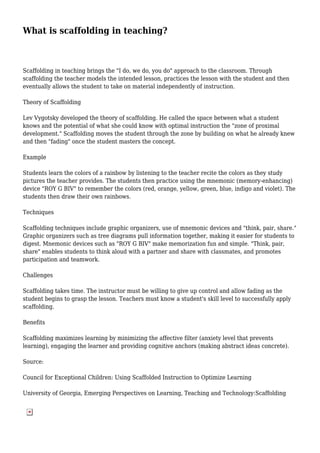What is scaffolding in teaching?
•
1 like•1,560 views
Scaffolding in teaching brings the "I do, we do, you do" approach to the classroom. Through scaffold...
Report
Share
Report
Share
Download to read offline

Recommended
Recommended
More Related Content
What's hot
What's hot (20)
Viewers also liked
Viewers also liked (7)
Teaching english as a foreign language language skills

Teaching english as a foreign language language skills
Similar to What is scaffolding in teaching?
Similar to What is scaffolding in teaching? (20)
Balancing teaching and technology for remote education

Balancing teaching and technology for remote education
Discovery Method of teaching | PEDAGOGY ENTHUSIAST

Discovery Method of teaching | PEDAGOGY ENTHUSIAST
What is scaffolding in teaching?
- 1. What is scaffolding in teaching? Scaffolding in teaching brings the "I do, we do, you do" approach to the classroom. Through scaffolding the teacher models the intended lesson, practices the lesson with the student and then eventually allows the student to take on material independently of instruction. Theory of Scaffolding Lev Vygotsky developed the theory of scaffolding. He called the space between what a student knows and the potential of what she could know with optimal instruction the "zone of proximal development." Scaffolding moves the student through the zone by building on what he already knew and then "fading" once the student masters the concept. Example Students learn the colors of a rainbow by listening to the teacher recite the colors as they study pictures the teacher provides. The students then practice using the mnemonic (memory-enhancing) device "ROY G BIV" to remember the colors (red, orange, yellow, green, blue, indigo and violet). The students then draw their own rainbows. Techniques Scaffolding techniques include graphic organizers, use of mnemonic devices and "think, pair, share." Graphic organizers such as tree diagrams pull information together, making it easier for students to digest. Mnemonic devices such as "ROY G BIV" make memorization fun and simple. "Think, pair, share" enables students to think aloud with a partner and share with classmates, and promotes participation and teamwork. Challenges Scaffolding takes time. The instructor must be willing to give up control and allow fading as the student begins to grasp the lesson. Teachers must know a student's skill level to successfully apply scaffolding. Benefits Scaffolding maximizes learning by minimizing the affective filter (anxiety level that prevents learning), engaging the learner and providing cognitive anchors (making abstract ideas concrete). Source: Council for Exceptional Children: Using Scaffolded Instruction to Optimize Learning University of Georgia, Emerging Perspectives on Learning, Teaching and Technology:Scaffolding